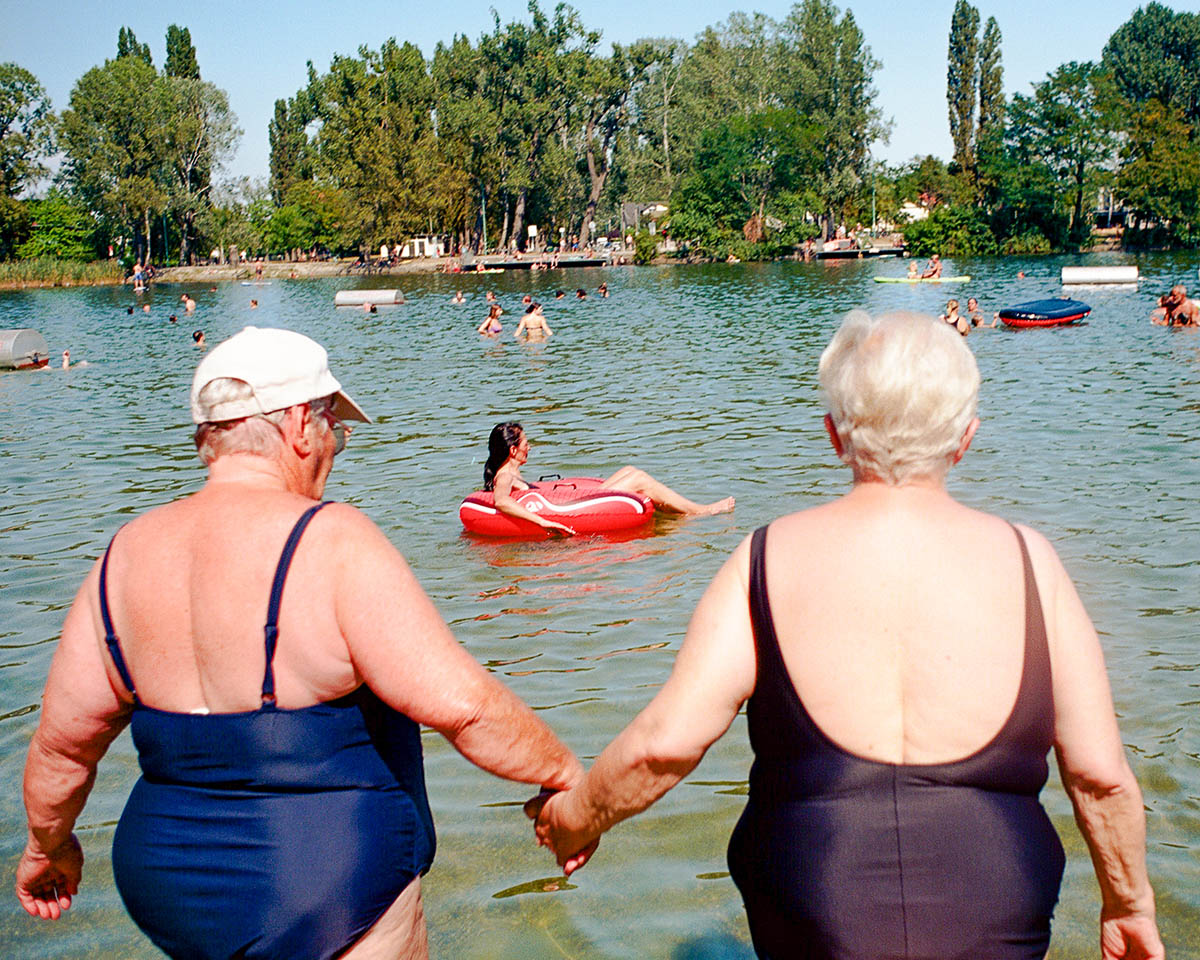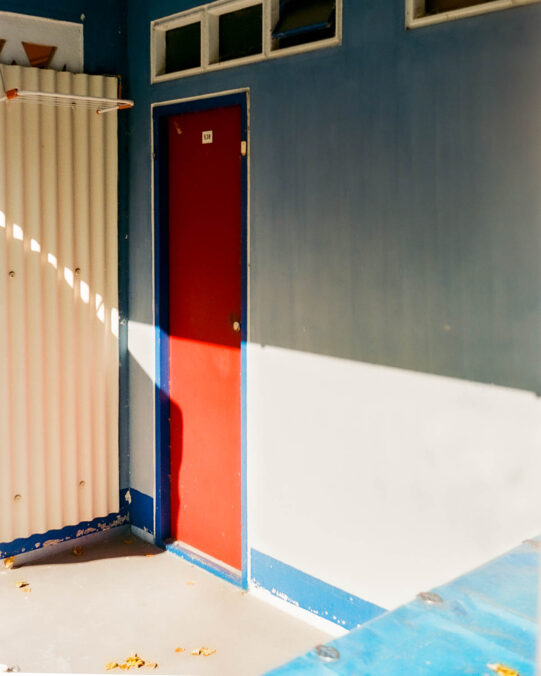
You published “Plantsch! A Summer in the Gänsehäufel” two years ago. How did that come about? What inspired you to document the everyday lives of people at the Gänsehäufel?
For me, as for many Italians that live here, it is not always easy to access and feel close to Viennese people. Since my stay in Vienna began, I have wanted to feel connected to the local culture. Investigating and experiencing daily life and the repetitive gestures of a typical Viennese man or woman archetype would have been the key to that purpose. Following this spirit, a combination of inspirations brought me to the wish of portraying this special place. The series of Documentaries “Alltagsgeschichte” (stories of daily life) by the amazing local journalist Elizabeth Spira was one of them. Also one of the episodes is about Gänsehäufel.

Some friends of mine introduced me to Gänsehäufel, and we visited it. I immediately thought about how it would embody all the characteristics listed before. I saw a kind of summer version of the socialist Vienna I love. Plus, it had somehow a “touch of “Italy. The water, the deck chairs, the people gathering around tables and building communities—it felt nostalgic and charged with humanity.
Not to be forgotten: Thanks to the founding of the district “Donaustadt” ’s cultural department, I could eventually make it happen and organize a proper exhibition at the end.



Born in Rome, living in Vienna. How do you see the city – how would you describe Vienna in your own words?
Born in Rome but grew up in a small village, Bassano Romano, 50 km from the capital. Vienna was from the first moment the city of liberation for me and of a new life. I was 24 at that time, my first real well-paid job, and my first time away from my beloved Italy for a long time. With this background, I discovered a city with plenty of possibilities. Vienna inspired my political interest and activism for example. And photography a bit later. A form of art that I completely ignored before I saw by chance the work of Italian photographer Piero Percoco exhibited in Vienna, to whom I own so much (also the curator of the editing of “Plantsch”, both for the exhibition and the publication).
It is funny because the first time I came here for the job interview (for my PhD position), I was sleeping for two nights in a hotel in the historical center. It was April and it was crazy cold. The people were super unfriendly and, since I spent these 2 days only in this historical center, Vienna only showed me this classical, imperial, boring, touristic, rich aspect. When I was back in Italy some days later and I got the call telling me I got the job, I thought I didn’t Vienna at first impression. Wrong one, since this city is so vital, especially among young people. You just need to know where to find that. Luckily I still decided to take the job at that time, because Vienna is the place I want to stay despite the cultural gap I am still feeling due to my Italian roots. Now I feel in a kind of balance with the locals. It is not a chance that In every interview I say I define myself as half Italian half Viennese (not Austrian, careful).


How do you feel while photographing in the Gänsehäufel? Is it a typical place where you spend lots of time, or not?
It felt good and bad at the same time (mostly good though). I go in the summer every day bathing at the Danube but not so often in Gaensehaeufel. It is not a typical place for people of my age. Mostly loved by retired people, for many of them, who live in a small apartment in the city and cannot afford it, the summer in Gänsehäufel is considered as a vacation substitution or as time in their garden. This social aspect of the place was certainly one of my main motivations. I had so many images in my mind I wanted to realize but on the praxis, I was just a young lady going around with a big old camera trying to approach skeptical old ladies and men in bathing suits (or naked) who tried to relax and did not want to be disturbed. On the other hand, it was probably the most satisfying and intense experience I had in photography. It took time to accept that 90 percent of the process doesn’t have to involve the act of making photos but rather observing, chatting, taking notes, relaxing, feeling, making mistakes, and so on. I set some rules for my practice then. For every person I got to know, I would first meet them at least 5 times for a coffee and a beer and only at the end, make a portrait session with one and only one film roll (in my case with the medium format 6×7 it means 10 frames when I am lucky). I heard so many stories, I understood so much… And the day of the exhibition, when many of my Gänsehäufel friends (all ages, also an 86-year-old sweet couple) also came, was one of the best days of my life.




What role do you see yourself in as a photographer?
I think constantly about photography. I mostly do it for myself, as a natural need but of course, I want my photography could reach the heart of most people possible. I don’t want to be something enjoyable only in a closed bubble. When I have a topic, I become like a sponge I enjoy this starting point where every sign in my daily life, every face and stranger encounter on the street seems to play the script for my story. Scenarios of potential pictures are taking form in my mind, I would dream about them. And then, guess what? Mostly none of them would end up becoming final pictures. Still, they served the process. You know, there is a perfect sentence from the last scene of a movie by of one my favorite director Pier Paolo Pasolini that resumed perfectly my spirit in photography “Perché realizzare un’opera quando è così bello sognarla soltanto?” („Why make an artwork when it is so beautiful to only dream about it?”)
Is there a picture of you in the book?
No, in this case, there is no sign of my physical presence, if I remember correctly. Different is the case of my latest book “Regina”: There are two photos of me there, shot by the protagonist of the story.


What was the biggest surprise you had during your time at the Gänsehäufel?
I had many positive surprises – one of them was that I was able to bathe and even enjoy bathing without any clothes at the nudist beach of Gänsehäufel.
What role does chance play in your work?
A big one. It is like a circle passing through two points: chance and intention. Without chance and encounters, I would not have input to feed my imagination. Still, it is important that this raw material is filtered then later and elaborated to have a picture in my mind. Then again, leaving possibilities open.
How would you summarize the dynamics of the place in one word or phrase?
Very Viennese … with Italian resemblances.

Where do you prefer to spend your nights in Vienna?
I love bars. It is my favorite free-time activity with friends. I also love the specific kind of “bars” of Vienna. This is where I go alone and what people here would call Beisl or Tschocherl. It is a kind of small, opposite of a fancy bar, populated by the same regulars every day. I don’t like these separations between people. For me, it is important as a photographer to shorten the differences by finding what we have in common more than highlight what keeps us apart.
What are you currently working on? How do you spend your winters?
I am a Mediterranean person; I hate the cold days—winter means productivity. I am very busy with university and trying to combine it with my work duties. I want to concentrate on my photographic career, and I am planning a four-month stay in Minnesota for an internship with my favorite photographer, Alec Soth. I am also working on a double photo project for the semester topic at my university, “Image and Sound.”
Beatrice Signorello – www.instagram.com/siamosoloconchiglie
Born in 1993 near Rome, Beatrice Signorello pursued her studies in mathematics in Rome and obtained in Vienna her PhD in the same field. Her photographic journey, starting with street photography, evolved into storytelling and portrait photography, as showcased in her projects „Plantsch! A Summer at Gänsehäufel“ and “Regina”. Signorello’s photographic vision focuses on capturing the hidden layers of human emotions and interactions, blurring the lines between the mundane and the extraordinary. She is currently studying at the University of Applied Arts in Maria Ziegelböck’s class, following her graduation from the Kubelka School for artistic photography.





